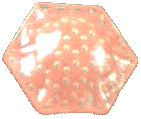
Let's forget the preliminaries and
Warm glass is really a misnomer. The operations generally included in this category, such as sagging or fusing, can take place anywhere between 1200 and 1700 degrees Fahrenheit. Is that what you'd call warm? Most people would call it HOT! The reason the term "warm glass" has been widely adopted is because most furnace work, including casting and blowing, takes place between 1700 and 2300 degrees. So, compared to that, kiln work has taken the secondary place of being only "warm."
The most important, and obvious piece of equipment is the kiln itself. There are many manufacturers today of kilns suitable for the small studio, and even the home.
There is a class of mini-kilns, called "toaster" kilns because that's about the size and shape of them. They are lightweight, heat very quickly and are ideal for fusing small batches of glass jewelry. Their size pretty effectively limits them to that one function, though. Toaster kilns generally run in the $300 range.
In larger kilns, the major difference between ceramic and glass kilns is the maximum temperature they reach. Most ceramic kilns are capable of reaching at least 2200F, (although temperature ratings of ceramic kilns are given as a cone rating, rather than a temperature rating) while as a rule, glass kilns are usually designed only to reach about 1700F.
Another difference is that ceramic kilns almost always have their elements in the walls. That's great for a kiln full of pottery stacked from floor to lid, but not the best arrangement for flat glasswork.
Many glass kilns have the element in the ceiling of the kiln, which for a top-loading design, means the element is in the door. The element in the top of the kiln makes for more even heating over a flat sheet (or sheets) resting on a shelf or a mold.
While ceramic kilns can be electric, gas, oil, or even wood fired, glass
kilns are almost always electric.
see my page with two Skutt Kilns
for a small taste of what's available.
The second most important piece of equipment depends on whether you're fusing, or sagging/slumping.
For fusing, a shelf made of clay, silicon carbide, lightweight castable refractories, or even ceramic fiber paper or boards is used. This is the surface upon which you will arrange your glass(es) and/or other materials to be fused.
For sagging and slumping, you will need a mold. This can be of ceramic
material, castable refractories, metals, plaster mixtures, specialized
ceramically hardened fiber papers, or even something as simple as a rock.
(if a rock is used, it must be pre-fired very slowly to allow any trapped
moisture to escape - a moisture laden rock fired at normal glass firing
rates often results in an explosion!)
Which mold material you use depends on whether you are allowing the glass
to slump over, or to sag into the mold. Other factors may include whether
it is to be a one of a kind piece, or a production run of many pieces, and
if the desired shape will lock the mold in, making it necessary to break the
mold up into small pieces in order to remove it from the glass.
Many mold materials will fuse right to the glass, so unless the mold is made of graphite, some sort of mold release or separator is necessary. These are commonly called shelf primers or kiln washes. Type of glass, type of mold, and how hot you're getting it will determine which type of release is best. Materials commonly used are whiting (calcium carbonate), and kaolin/alumina mixtures (basically, high-fire clay). There are several commercial preparations available. Usually they are of a kaolin and alumina base with additives to allow the solids to stay in suspension longer. These are mixed with the proper amount of water, and applied while still well mixed. The solids will settle out eventually, but they will stay suspended long enough to be able to apply an even coat over the mold or shelf.
That's really the essential warm-glass toolkit. A kiln, something to melt or form the glass on, and something to keep it from sticking.
One of the highly recommended optionals is heat resistant gloves. Formerly made of asbestos, high temperature gloves today are made of a variety of materials. Many people put gloves in the "essentials" category, but if you are just arranging glass on shelf or mold, turning the heat up, and watching through the peephole for visual maturity, you really can get by without them. They are, however the highest priority of the optionals. Eventually, you will want to move something, or rake an arrangement, or even just open the lid for a better look than is possible through the peephole.
Without the gloves, none of that will be easily accomplished. I went through two of my wife's oven mitts and a few pot holders before I finally sprung for my pair of nearly elbow-high Kevlar gloves. They really do make things a lot easier.
Glass operations in the kiln can be broken down into two categories.
They are forming and fusing.
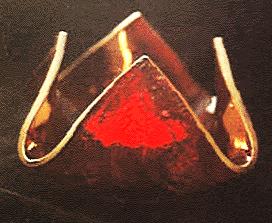
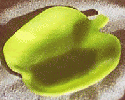
Forming is usually referred to as sagging or slumping. Those two words are often used interchangeably, but when there is a differentiation it is that sagging refers to a piece of glass supported at its edges, so when it's heated, the center sags down to conform to the mold. Slumping refers to the opposite situation, where the glass is supported in the middle, and the edges slump down to conform to the mold.
The biggest difference between these two styles of forming glass is that in sagging, the glass is supported around the entire periphery of the mold, so thins out as it stretches to conform to the mold.
In slumping, there's only one point of support, so as the glass folds down over the mold, the excess glass has nowhere to go but to fold in upon itself. Depending on the shape of the mold, you can have effects which vary from a slight thickening of the glass, all the way to a draped effect, just as if you'd draped a heavy fabric over the mold.
Other ways to form glass don't use a mold at all. There are many techniques whereby a design is "pressed" into the bottom of the glass by allowing it to soften while atop layers of ceramic paper, metal rods, or lines of thick pasty investment laid down in a pattern on the kiln shelf. Copper wire can be strung in various ways through the kiln, and the glass allowed to drape over that. Your imagination is the limit, here (and the combustion or melting point of a potential mold material). Just keep in mind that soft glass likes to stick to things, so you need to use a releasing agent, or your shaping element must be able to be cleaned out of the glass afterwards.
Forming can even be accomplished by hand. Through the use of a stainless steel rod, (and here you will absolutely need those heat resistant gloves) glass can be manipulated to get shapes not possible through any of the above methods.
In forming glass where gravity is the prime mover, effects are realized through a combination of time and temperature. Many new kiln owners neglect the time aspect of this combination.
To illustrate, suppose a particular piece of glass is placed on a shallow sagging type of dish mold. The kiln temperature control is set on "High." In 60 minutes the temperature has reached 1325 degrees F. and the glass has completely conformed to the mold.
Now, the kiln is loaded with the same glass set upon the same mold. This time the temperature control is set on "medium." In 90 minutes it will be observed that the glass has completely conformed to the mold, yet a check of the pyrometer will reveal a temperature of only 1250 degrees F.
With most mold shapes, identical results can be achieved at higher temperatures for shorter periods of time, or lower temperatures for longer periods of time.
There are certain types of glass which may want to devitrify at the
higher temperatures, so at times it will be necessary to go the lower
temp/longer time route.
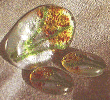
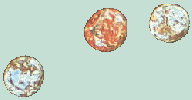 Fusing is the softening of glass to the extent that it will become
permanently united with whatever is in contact with it. Usually, that's
other glass, but often times it can be metal or other materials.
Fusing is the softening of glass to the extent that it will become
permanently united with whatever is in contact with it. Usually, that's
other glass, but often times it can be metal or other materials.
The most important consideration in fusing is that the parts to be fused are both/all compatible.
What does compatible mean? It means the different glasses or materials must expand and contract the same amount over a given temperature variation. If two pieces of incompatible glass are fused, one will contract more upon cooling than the other. Internal stresses are formed, and the piece will crack. If the incompatibility is severe, the cracks will already be evident upon opening the kiln. Less severe incompatibility can show cracks weeks, or even months later.
Compatibility is determined in a number of ways, the easiest being to compare the COE values of the glasses to be fused. COE stands for Coefficient Of Expansion. Types of glass which are generally fused will be in the range of 85 to 105. (a COE of 96 means a change in dimension of .00096% for each degree Celsius) The normally accepted range for compatibility is +/-1. A glass with a COE of 96 would therefore be compatible with any glass in the range of 95 to 97. The drawback with this method is that often times the COE of a piece of glass is unknown.
Another way to determine compatibility is to fuse a test piece. Insure it is properly annealed, and shine polarized light through it. View the transmitted light through a polarizing lens at right angles to the polarization of the source light. Any areas of stress will show as light areas. Non-stressed areas will appear dark. The drawback with this method is that it will only work with transparent type glasses.
There are other ways to determine compatibility, using a torch or kiln, but those will be left unaddressed for now.
Fusing, too, is a function of both time and temperature, although less so than forming. The temperature generally referred to as "full-fuse" temperature is 1500 deg. F. This is the temperature where most glass is fluid enough to form a single mass of glass from separate pieces. (normally in about 15 minutes).
Within the category of fusing are also many specific items which can
be fused within layers, or to the surface of glass.

Often times, various items to be fused together want to roll, or shift.
Different types of glue may be used to hold things in place, but if glue
is used, the kiln must be vented until the organics burn off. Generally,
when using glue, it's a good idea to let the kiln vent at least up to
800 deg. F. Without providing for ventilation, the materials which
offgas can cause a cloudy film to form in the surface of the glass. It's a
good idea to do a test piece if you're using a new glue. Some glues have
high ash content and, while that effect can be artistically used, it can ruin
a piece when unintended.
ANNEALING is as important as compatibility.
Annealing is the controlled cooling of glass, such that no internal stresses are formed during cooling. If the outside skin of the piece cools much more quickly than the interior, stresses are formed which will show up later as cracks (or worse).
Each glass formulation has its exact anneal point, determined by viscosity. Anneal points for most glass will be in the neighborhood of 975 deg.F. If the glass is held at its exact anneal point, all internal stress will be relieved after 4 minutes. In thicker pieces, it may take a while for the entire mass of glass to reach that point, but once it has, 4 minutes is all it has to be held there.
About 75 degrees below the anneal point is another viscosity-determined benchmark known as the strain point. It is the transition between anneal point and strain point which is the most critical. If the temperature is brought down quickly from working temperature to the strain point, it takes 4 hours for internal stresses to be relieved here. Below the strain point, no significant annealing can take place.
Annealing is much less a concern with forming glass only a single sheet thick because the temperatures at the skin and core of a single sheet can equalize fairly rapidly. Annealing single sheet pieces normally consists of nothing more than shutting the power off, and allowing the kiln to cool naturally, through the anneal point to the strain point. At that time, a small kiln post can be used to prop the lid open an inch or so for more rapid cooling.
For thicker pieces, it may be necessary to turn the kiln back on as
the temperature passes through the anneal point. Thicker pieces have
a much longer lag time for the core and skin temperatures to equalize.
Once the temperature has dropped below the strain point, the power
can be turned off, but in this case, the lid should remain closed.
Thicker pieces are also more susceptible to thermal shock.
In conclusion...
The most important ingredients of all in warm glass are imagination and inventiveness.
The basic recipe is extremely simple:
As long as you follow these rules, and sprinkle on copious quantities of creativity, you can't help but get rave results.
Kiln Firing Glass: Glass Fusing Book One ISBN: 0-9612282-3-7
Advanced Fusing Techniques: Glass Fusing Book Two ISBN: 0-9612282-1-0
Glass Casting and Moldmaking: Glass Fusing Book Three ISBN: 0-9612282-2-9
or
Fused Glass Handbook by Gil Reynolds ISBN: 0915807025
There is additional information about compatibility of glass on the Beadmaking page.
Other information about the heating and cooling of glass, and specs of Skutt's glass kilns, and time/temperature charts for the Skutt Pinto in particular can be found at the Warm Glass Page

updated 6 Dec 98